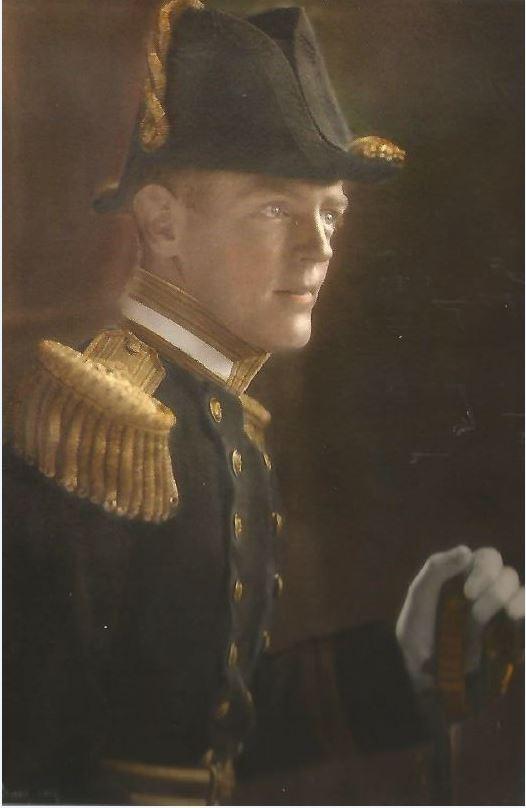'Everyone was so shocked'

Lieutenant Commander Alexander Wilkinson. Image: Courtesy Peter Wilkinson OAM
Peter Wilkinson OAM was six years old when his father was killed during the Second World War.
“I was out the front and the telegram boy arrived,” Peter said.
“That meant nothing to me, but the howls of anguish did. And my mother spent the next three or four days in bed. That was how they recovered in those days, and I remember that quite well.
“She was sobbing … and everyone was rallying around trying to reassure us that everything would be alright.”
Peter’s father, Lieutenant Commander Alexander Wilkinson, was the intelligence officer on board HMAS Sydney when it was sunk by the German raider Kormoran off the coast of Western Australia in November 1941.
Alexander Mackay Wilkinson, was born on 6 January 1906 in Queenscliff, Victoria, the son of Major George Wilkinson and his wife Gretchen.
George was a lieutenant colonel at army headquarters in Melbourne when Alexander Wilkinson joined the Royal Australian Navy as a cadet midshipman, just before his 14th birthday, in January 1920.
Wilkinson attended the Royal Australian Naval College at Jervis Bay and was serving at HMAS Penguin in Sydney when he married Peter’s mother, Eileen, in July 1933.
He spent time in the United Kingdom with the British Royal Navy and their eldest son, Peter, was born in Cornwall, England, in 1935. He was christened on board the British battleship HMS Rodney.
Wilkinson returned to Penguin after the outbreak of war and was posted to Sydney as intelligence officer in July 1941.
The pride of the Royal Australian Navy, Sydney had demonstrated its fighting prowess in the Mediterranean, sinking the Italian cruiser Bartolomeo Colleoni and returning to a hero’s welcome in Australia in February 1941.
In late September 1941, the cruiser began operating off the Western Australian coast, escorting convoys from Fremantle to the Sunda Strait in the Netherlands East Indies. From there, the convoy would be handed over to other Allied warships to continue to Singapore.
Sydney was steaming back to Fremantle on the afternoon of 19 November when it spotted a suspicious merchant ship, disguised as Dutch steamer Straat Malakka. It was, in fact, the heavily armed German merchant raider Kormoran, which had sunk ten unsuspecting merchant ships in the Indian Ocean and taken another as a prize.
Sydney had almost drawn alongside the mysterious vessel when it hoisted its German naval ensign and opened fire with guns and torpedoes.
In the battle that followed, both ships were mortally damaged. As the German sailors abandoned their stricken vessel, they watched the Australian cruiser, now only a distant glow on the horizon, disappear into the night. Torpedoed and ablaze, Sydney sank in the early hours of 20 November. The entire ship’s complement of 645 was lost.
“Everyone was so shocked,” Peter said.
“It was very much the pride of the fleet, and they didn't want to tell the nation what had happened.”
“One of the rather tragic things is that my father was only on the ship from about August to November, which is only about three or four months.
“And he was gone, just like that.”
Peter’s younger brother, Michael, was only a baby at the time.
Their mother, stricken with grief, never spoke about the war, or their father.
“Hardly anyone ever did in those days. And it still happens today. Even the people who come home from war don’t want to talk about the atrocities that happened,” Peter said.
“Where we lived in Mosman, there were about half a dozen widows of those who went down in the Sydney …
“They had a pact in those days. They never spoke about it. And none of them ever remarried.”
Today, Peter’s father is commemorated on the Plymouth Naval Memorial in Britain, the HMAS Sydney II Memorial in Geraldton, the HMAS Sydney Memorial at Bradleys Head on Sydney Harbour, and the Roll of Honour at the Australian War Memorial in Canberra.
In November 2015, Peter laid a wreath in his father’s honour at a special Last Post Ceremony at the Memorial.
As a boy growing up in Mosman, he lived across the road from Sydney architect John Crust. Crust was one of the architects responsible for the design of the Memorial, and Peter has fond memories of being shown “thousands and thousands of these magnificent, hand-drawn, engineering specifications and architectural specifications”.
Eighty years on, Peter treasures the few memories he has of his father.
“I'd drawn a map of Tasmania, which he was able to point out to me was upside down, so I remember that, and I remember the map, but I don't remember him,” Peter said.
“We just got on with life and tried to forget that it happened…
“I've tried to follow in his footsteps somehow … He gave his life for his country, and I've dedicated quite a bit of mine to community service over the past 60 years …
“Like a lot of them, he was there one day and gone the next.
“We just have to handle it as best we can … but I always get back to the madness of war. It's the only word I keep coming back to … but no one seems to learn … hundreds of millions have been killed… and for what?”

